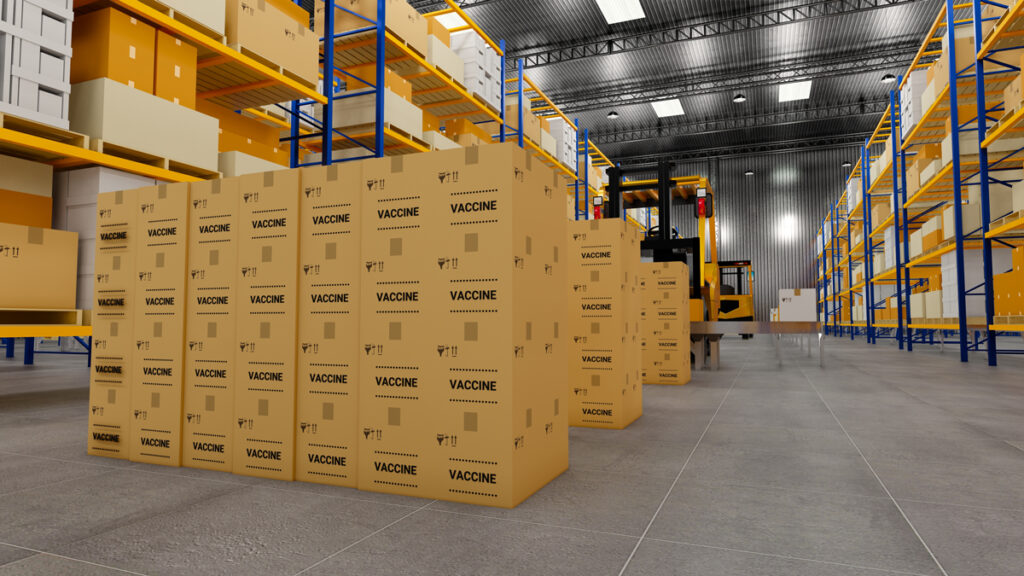Where we stand in our bid for total pandemic preparedness.
January 2023 – The Journal of Healthcare Contracting

The Girl Scouts, the Boy Scouts and the U.S. Coast Guard have the right idea: They’re always prepared. It says so in their mottos. How about the healthcare supply chain? Not quite, as COVID-19 demonstrated. However, since March 2020, lawmakers and supply chain organizations have instituted and promoted many safeguards to better prepare us for next time. They include:
- CARES Act.
- Trucking Action Plan.
- Freight Logistics Optimization Works initiative.
- Ocean Shipping Reform Act of 2022.
- PREVENT Pandemics Act.
- A “fast pass” system for medical supplies and equipment.
So, can we say we are “always prepared?” Maybe not. But it’s safe to say we are better prepared.
“Partnerships and information-sharing between the commercial market and federal agencies have never been stronger,” says Linda Rouse O’Neill, vice president, supply chain policy, and executive branch relations, Health Industry Distributors Association (HIDA). Over 10 federal partners participated in discussions with supply chain executives at HIDA’s Pandemic Preparedness Summit on how to continue to build on the partnership, the future of data sharing and communications, she says.
Mike Schiller, senior director of supply chain for the Association for Health Care Resource & Materials Management (AHRMM) of the American Hospital Association, says, “We are better prepared in several aspects, and in others, the changes have been slower to come.
“The biggest factor contributing to our increased preparedness is the amount of public/private collaboration that is taking place – more than I can recall during the tenure of my career. Supply Chain and clinical professionals, trade associations and other subject matter experts are working alongside regulatory experts as we identify the failure points and determine what resiliency is and what steps are necessary to build it into the health care supply chain.”
David Mintz, chief supply chain officer for NDC, believes COVID-19 has increased volatility, uncertainty, complexity and ambiguity (VUCA) for supply chains. But, he adds, “Through this experience, most supply chain professionals have improved their expertise and acumen to better manage in this environment. Similarly, processes and technologies have evolved over the last couple of years to better cope with challenges brought to light during the pandemic.”
Still, there’s plenty of work to be done, he says. “As we bolster the supply chain and continue to address both domestic and global vulnerabilities exposed during the pandemic, achieving a balance between onshore and offshore partnerships will be critical. The onshoring movement was accelerated by the pandemic, and the instabilities uncovered in the supply chain triggered a re-evaluation of costs, risks and resilience that will drive us into a better preparedness plan.”
CARES Act
Enacted in March 2020, the CARES Act gave the FDA’s Center for Devices and Radiological Health (CDRH) statutory authority to help mitigate and prevent device shortages during or in advance of a public health emergency. It is the first time the FDA was given such authority.
The Act requires certain medical device manufacturers to provide information to the FDA on product availability and potential meaningful supply chain disruptions, during or in advance of a public health emergency. With that authority, CDRH can better understand and monitor the complex web of supply chains that feed the medical device industry and be more proactive in solving problems before they occur, according to the FDA. For example, the agency worked with testing and diagnostics manufacturers to help ease shortages of resins that were the result of the February 2021 Texas winter storm.
CDRH reports it is working with over 1,000 manufacturers and suppliers in 12 countries to manage and monitor supply chain shortages identified on the FDA shortages list, as well as other devices deemed critical to public health during the pandemic. The agency also says it has repurposed 130 employees to work full- or part-time on shortages.
Trucking Action Plan
In December 2021, the U.S. Departments of Transportation and Labor announced a Trucking Action Plan, intended to address shortages in the trucking workforce. Seventy-two percent of goods in America are shipped by truck, and in most communities, trucks are the only form of delivery, according to the White House. “But outdated infrastructure, the COVID-19 pandemic, and a historic volume of goods moving through our economy have strained capacity across the supply chain, including in trucking.”
The Action Plan is intended to accelerate the expansion of Registered Apprenticeship programs for drivers, take steps to address pandemic-driven delays in getting a commercial driver’s license, curb the proliferation of low-quality training, and expand more seamless paths for veterans and underrepresented communities, such as women, to access good driving jobs.
Freight Logistics Optimization Works
Though not specifically targeting healthcare, the Biden administration’s Freight Logistics Optimization Works (FLOW), led by the Department of Transportation, will pilot the exchange of key freight information among 18 participating supply chain companies, including ports, ocean carriers, terminal operators, businesses, trucking firms and logistics/warehousing firms.
“The goods movement chain is almost entirely privately operated and spans shipping lines, ports, terminal operators, truckers, railroads, warehouses, and cargo owners such as retailers,” according to the White House. “These different actors have made great strides in digitizing their own internal operations, but they do not always exchange information with each other. This lack of information exchange can cause delays as cargo moves from one part of the supply chain to another, driving up costs and increasing goods movement fragility.”
Ocean Shipping Reform Act
Like FLOW, the Ocean Shipping Reform Act, signed into law in June 2022, is not healthcare-specific, but its provisions will have an impact on importation of medical goods.
The Act is intended to control “demurrage and detention” fees for shipping containers, which rose dramatically during COVID-19. (“Demurrage” refers to charges raised when a full container is not moved out of the port terminal for unpacking within the allowed free days offered by the shipping line, according to Chicago-based logistics firm project44. “Detention” refers to fees raised when the importer picks up the container for unpacking but has not returned the empty container to the depot within the agreed free-time.)
FLOW increases the authority of the Federal Maritime Commission to investigate complaints about detention and demurrage charges charged by common ocean carriers, and order refunds for unreasonable charges. It also prohibits common ocean carriers, marine terminal operators or ocean transportation intermediaries from unreasonably refusing available cargo space.
PREVENT Pandemics Act
In March 2022, two U.S. senators introduced the Prepare for and Respond to Existing Viruses, Emerging New Threats, and Pandemics Act (PREVENT Pandemics Act), intended to strengthen public health and medical preparedness and response systems in the wake of COVID-19.
Among other provisions, the Act – which was pending in the Senate as of mid-September – calls for establishment of an Office of Pandemic Preparedness and Response Policy (OPPRP) within the Executive Office of the President to advise on pandemic preparedness and response policy and support coordination within the federal government related to it.
If passed, the Act would pick up several pieces from earlier proposed legislation to improve the Strategic National Stockpile (SNS). For example, it would:
- Amend the SNS Annual Threat-Based Review to include an assessment of the supply chains and any vulnerabilities for products that SNS plans to purchase.
- Clarify that the Department of Health and Human Services should ensure that items in the stockpile are in working condition so they can be readily deployed when needed.
- Require that HHS issue guidance on how states, territories, and Tribes can access the SNS.
- Authorize HHS to enter into contracts for the SNS to enhance surge capacity and supply chain flexibility through vendor-managed inventory and warm-base domestic manufacturing arrangements.
- Authorize HHS to sell excess products from the SNS to other entities when the cost of maintaining these products in the SNS is not appropriate to meet the needs of the SNS.
The PREVENT Pandemics Act has received endorsements from HIDA as well as the National Governors Association.
“The PREVENT Pandemics Act takes a comprehensive approach to the lessons learned from the federal response to the COVID-19 pandemic,” says Patrick Bailey, vice president, Congressional relations, HIDA. “It includes input from industry, including HIDA, that recognizes the vital role of public-private partnerships in managing medical supplies during a pandemic.”
The National Governors Association expressed its support for the PREVENT Pandemics Act in a letter in April to the sponsoring senators. “During the early phase of the pandemic, when PPE shortages were widespread, governors did not have transparency into what was in the Strategic National Stockpile and how decisions were being made on the distribution of these critical supplies,” they wrote. “States scrambled to find essential medical supplies and competed against ourselves and the federal government to procure those scarce supplies.
“It is critical that the federal government be transparent with governors as to what is in the SNS, assist states in maintaining adequate and updated medical supplies in their state stockpiles, incentivize domestic manufacturing of PPE and medical supplies, and ensure an equitable and fair distribution of federal support in order to mitigate the spread and reduce the impact of future pandemics.”
Fast Pass

HIDA and two other groups – the Advanced Medical Technology Association (AdvaMed) and International Safety Equipment Association (ISEA) have expressed support for a Critical Cargo Program, or “fast pass” system, which would prioritize critical medical supplies and equipment during current and future pandemics, and align transportation operations – shipping, railroad, trucking and small parcel carriers – to support healthcare during public health emergencies.
In an October 2021 letter to the U.S. Department of Transportation, HIDA’s Linda Rouse O’Neill pointed out the plan, if implemented, would:
- Prioritize critical supplies for container access and sea freight space.
- Ensure first available railcar and chassis.
- Provide for 24/7 transportation operations during a public health emergency.
- Develop an intermodal communication plan on when and how medical products can be accessed.
“Through our Shipping Council, HIDA has brought together distributors with port officials to expedite medical products through ports such as Los Angeles, Long Beach, Savannah and the Port Authority of New York & New Jersey,” O’Neill said in September. “We have brought the issue to the attention of federal officials at the Federal Maritime Commission and U.S. Department of Transportation. We are encouraged by this outreach. Long term, we are working on legislation to establish a fast pass pilot program for critical cargo such as medical products.”
What’s next?
While the U.S. healthcare system may be better prepared than it was before the pandemic, it must sustain certain “touch points,” such as strengthening of the Strategic National Stockpile, says O’Neill. “Otherwise, we will lose the ‘muscle memory’ of crisis response that can be used during the next adverse event.
“As leaders in our industry, it is incumbent on us to keep this synergy going so the next set of stakeholders won’t have to reinvent the wheel for the next challenge. Additionally, we need to work with policymakers for constant and reliable funding to carry forward the partnerships and collaborative work done through the COVID-19 response.”
Says Mintz, “In addition to the many initiatives, time will also be a factor towards improving U.S. preparedness. The pandemic continues to significantly change demand patterns and supply capacities, often creating meaningful imbalances that lead to shortages. Over time, as specific markets become more stable, market forces coupled with technological innovations will naturally drive supply and demand into better alignment.”
Mike Schiller of AHRMM believes that “many moving parts need to be aligned before a comprehensive resiliency solution is in place – not just within the U.S. health care supply chain, but the global supply chain. Resiliency comes at a cost. Onshore/near-shore manufacturing, multisource contracts, building buffer inventory within the existing supply chain infrastructure, aligning incentives and the thoughtful adoption of technology will all require culture change, considerable financial and human resources, and process redesign.”
